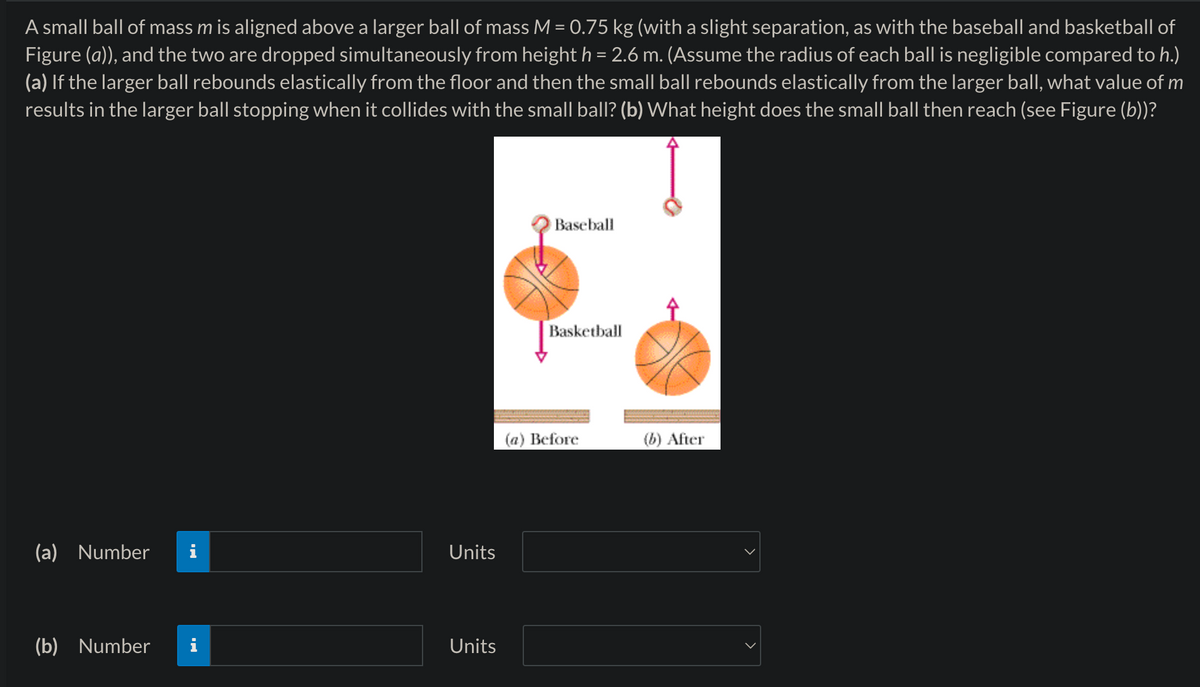A small ball of mass m is aligned above a larger ball of mass M = 0.75 kg (with a slight separation, as with the baseball and basketball of Figure (a)), and the two are dropped simultaneously from height h = 2.6 m. (Assume the radius of each ball is negligible compared to h.) (a) If the larger ball rebounds elastically from the floor and then the small ball rebounds elastically from the larger ball, what value of m results in the larger ball stopping when it collides with the small ball? (b) What height does the small ball then reach (see Figure (b))? Baseball Basketball (a) Before (b) After
A small ball of mass m is aligned above a larger ball of mass M = 0.75 kg (with a slight separation, as with the baseball and basketball of Figure (a)), and the two are dropped simultaneously from height h = 2.6 m. (Assume the radius of each ball is negligible compared to h.) (a) If the larger ball rebounds elastically from the floor and then the small ball rebounds elastically from the larger ball, what value of m results in the larger ball stopping when it collides with the small ball? (b) What height does the small ball then reach (see Figure (b))? Baseball Basketball (a) Before (b) After
Physics for Scientists and Engineers: Foundations and Connections
1st Edition
ISBN:9781133939146
Author:Katz, Debora M.
Publisher:Katz, Debora M.
Chapter11: Collisions
Section: Chapter Questions
Problem 77PQ
Related questions
Question

Transcribed Image Text:A small ball of mass m is aligned above a larger ball of mass M = 0.75 kg (with a slight separation, as with the baseball and basketball of
Figure (a)), and the two are dropped simultaneously from height h = 2.6 m. (Assume the radius of each ball is negligible compared to h.)
(a) If the larger ball rebounds elastically from the floor and then the small ball rebounds elastically from the larger ball, what value of m
results in the larger ball stopping when it collides with the small ball? (b) What height does the small ball then reach (see Figure (b))?
(a) Number
Units
(b) Number
Units
Baseball
Basketball
(a) Before
(b) After
Expert Solution
This question has been solved!
Explore an expertly crafted, step-by-step solution for a thorough understanding of key concepts.
Step by step
Solved in 4 steps with 7 images

Knowledge Booster
Learn more about
Need a deep-dive on the concept behind this application? Look no further. Learn more about this topic, physics and related others by exploring similar questions and additional content below.Recommended textbooks for you

Physics for Scientists and Engineers: Foundations…
Physics
ISBN:
9781133939146
Author:
Katz, Debora M.
Publisher:
Cengage Learning

University Physics Volume 1
Physics
ISBN:
9781938168277
Author:
William Moebs, Samuel J. Ling, Jeff Sanny
Publisher:
OpenStax - Rice University

Principles of Physics: A Calculus-Based Text
Physics
ISBN:
9781133104261
Author:
Raymond A. Serway, John W. Jewett
Publisher:
Cengage Learning

Physics for Scientists and Engineers: Foundations…
Physics
ISBN:
9781133939146
Author:
Katz, Debora M.
Publisher:
Cengage Learning

University Physics Volume 1
Physics
ISBN:
9781938168277
Author:
William Moebs, Samuel J. Ling, Jeff Sanny
Publisher:
OpenStax - Rice University

Principles of Physics: A Calculus-Based Text
Physics
ISBN:
9781133104261
Author:
Raymond A. Serway, John W. Jewett
Publisher:
Cengage Learning

College Physics
Physics
ISBN:
9781938168000
Author:
Paul Peter Urone, Roger Hinrichs
Publisher:
OpenStax College

Classical Dynamics of Particles and Systems
Physics
ISBN:
9780534408961
Author:
Stephen T. Thornton, Jerry B. Marion
Publisher:
Cengage Learning